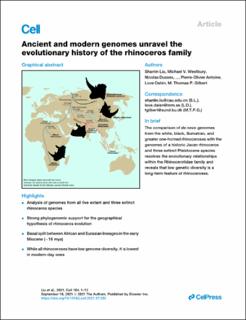| dc.contributor.author | Liu, Shanlin | |
| dc.contributor.author | Westbury, Michael V | |
| dc.contributor.author | Dussex, Nicolas | |
| dc.contributor.author | Mitchell, Kieren J. | |
| dc.contributor.author | Sinding, Mikkel-Holger S. | |
| dc.contributor.author | Heintzman, Peter D. | |
| dc.contributor.author | Duchêne, David A. | |
| dc.contributor.author | Kapp, Joshua D. | |
| dc.contributor.author | von Seth, Johanna | |
| dc.contributor.author | Heiniger, Holly | |
| dc.contributor.author | Sánchez-Barreiro, Fatima | |
| dc.contributor.author | Margaryan, Ashot | |
| dc.contributor.author | André-Olsen, Remi | |
| dc.contributor.author | De Cahsan, Binia | |
| dc.contributor.author | Meng, Guanliang | |
| dc.contributor.author | Yang, Chentao | |
| dc.contributor.author | Chen, Lei | |
| dc.contributor.author | van der Valk, Tom | |
| dc.contributor.author | Moodley, Yoshan | |
| dc.contributor.author | Rookmaaker, Kees | |
| dc.contributor.author | Bruford, Michael W. | |
| dc.contributor.author | Ryder, Oliver | |
| dc.contributor.author | Steiner, Cynthia | |
| dc.contributor.author | Bruins-van Sonsbeek, Linda G. R. | |
| dc.contributor.author | Vartanyan, Sergey | |
| dc.contributor.author | Guo, Chunxue | |
| dc.contributor.author | Cooper, Alan | |
| dc.contributor.author | Kosintsev, Pavel | |
| dc.contributor.author | Kirillova, Irina V. | |
| dc.contributor.author | Lister, Adrian M. | |
| dc.contributor.author | Marques-Bonet, Tomas | |
| dc.contributor.author | Gopalakrishnan, Shyam | |
| dc.contributor.author | Dunn, Robert R. | |
| dc.contributor.author | Lorenzen, Eline D. | |
| dc.contributor.author | Shapiro, Beth | |
| dc.contributor.author | Zhang, Guojie | |
| dc.contributor.author | Antoine, Pierre-Olivier | |
| dc.contributor.author | Dalén, Love | |
| dc.contributor.author | Gilbert, Marcus Thomas Pius | |
| dc.date.accessioned | 2021-09-16T08:27:50Z | |
| dc.date.available | 2021-09-16T08:27:50Z | |
| dc.date.created | 2021-08-26T17:07:45Z | |
| dc.date.issued | 2021 | |
| dc.identifier.issn | 0092-8674 | |
| dc.identifier.uri | https://hdl.handle.net/11250/2778478 | |
| dc.description.abstract | Only five species of the once-diverse Rhinocerotidae remain, making the reconstruction of their evolutionary history a challenge to biologists since Darwin. We sequenced genomes from five rhinoceros species (three extinct and two living), which we compared to existing data from the remaining three living species and a range of outgroups. We identify an early divergence between extant African and Eurasian lineages, resolving a key debate regarding the phylogeny of extant rhinoceroses. This early Miocene (∼16 million years ago [mya]) split post-dates the land bridge formation between the Afro-Arabian and Eurasian landmasses. Our analyses also show that while rhinoceros genomes in general exhibit low levels of genome-wide diversity, heterozygosity is lowest and inbreeding is highest in the modern species. These results suggest that while low genetic diversity is a long-term feature of the family, it has been particularly exacerbated recently, likely reflecting recent anthropogenic-driven population declines. | en_US |
| dc.language.iso | eng | en_US |
| dc.publisher | Elsevier | en_US |
| dc.rights | Navngivelse 4.0 Internasjonal | * |
| dc.rights.uri | http://creativecommons.org/licenses/by/4.0/deed.no | * |
| dc.title | Ancient and modern genomes unravel the evolutionary history of the rhinoceros family | en_US |
| dc.type | Peer reviewed | en_US |
| dc.type | Journal article | en_US |
| dc.description.version | publishedVersion | en_US |
| dc.source.journal | Cell | en_US |
| dc.identifier.doi | 10.1016/j.cell.2021.07.032 | |
| dc.identifier.cristin | 1929090 | |
| cristin.ispublished | true | |
| cristin.fulltext | original | |
| cristin.qualitycode | 2 | |

